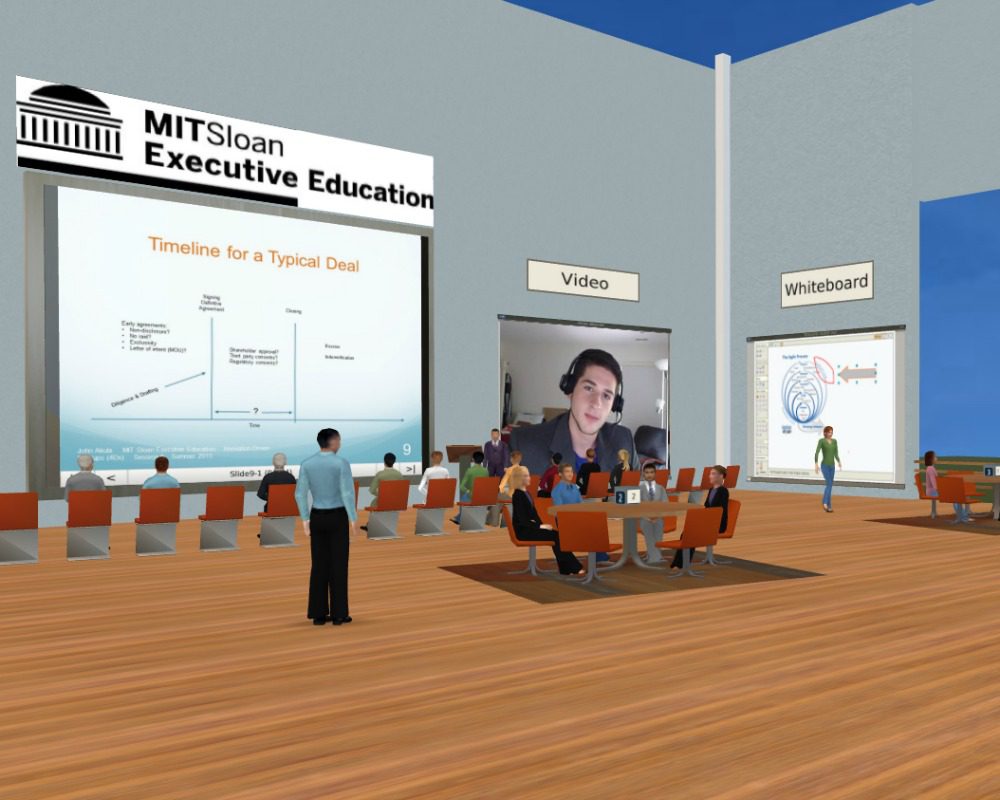As businesses, communities and municipalities braced for what would later be known as the most destructive storm of the 2012 Atlantic hurricane season, officials at MIT Sloan School of Management grappled with how to handle an upcoming executive education course scheduled for right around the time Hurricane Sandy would hit the Boston area.
Sloan Associate Director of Executive Education Peter Hirst said the school considered cancelling the big data program since travel had been paralyzed across the region. But nearly half of the program’s 100 participants were already in Cambridge, Massachusetts, for one course or another and could easily be expected to stay to attend the two-day course.
The team had been exploring new ways to translate management and executive education into a more interactive online and digital format. So Hirst’s team decided to use a delivery method they had been experimenting with over the past year — 4Dx technology.
This virtual world had been around for a number of years, but it had never really been used for business objectives, Hirst said. The school had used the platform in smaller ways, but the hurricane gave Sloan the opportunity to see whether this virtual classroom technology could create an effective experience for distance learners.
Technicians connected a live classroom of people attending in-person to a virtual one so people who couldn’t travel could see everything that was happening through streaming video, but they experienced it as a projection. If those participating virtually looked around the simulated space, they’d see other virtual attendees — all of them avatars. They could interact with each other, and simultaneously see what was happening in the live classroom. Hirst said the school even figured out a way for the avatars to walk up to a microphone in their virtual classroom, speak into it, be heard in the live classroom and vice versa — in real time.
Using 4Dx technology — the fourth dimension is audio — was an opportunistic solution in that moment of flux, Hirst said. “Although it was really technologically challenging to make that all work, it was still a sufficiently engaging experience for everyone concerned.”
Sloan continues to experiment with 4Dx technology to deliver programs virtually. Chief Learning Officer talked to Hirst to learn more about this approach.
How have you used the 4Dx platform since the big Hurricane Sandy rollout?
We now fairly regularly run courses on a variety of topics not just the data one that we started with. There are topics in management and innovation, even a program on business law for startups, and programs in general management that sometimes use these immersive worlds.
We’ve seen customers who have taken the programs ask us to maintain a virtual space using the same technology so they can get back together in between times to work on assignments for the program or, in many cases, to network or invite their own colleagues and customers into the virtual space to meet and talk about what they’ve been learning.
What are some of the benefits of using this kind of platform?
People don’t have to travel in order to interact with each other and with faculty in a learning experience. When we were delivering the simultaneous in-person and virtual experience, the factors that determined the way you delivered the in-person program determined what the experience was going to be like for the virtual people, as well. Courses could run two eight-hour days or five eight-hour days. In-person, you have to work that timetable, but when you go completely virtual you can change the delivery model from what’s been traditional in executive education. You can break up the course into a series of shorter modules spread out over time. This gives participants much more time to reflect on what they learn in each session, and even go out and practice a little bit in their own organization before coming back.
What challenges did you come across?
There was a learning curve for people using the technology for the first time, whether it was faculty or participants. But it really takes 15 to 20 minutes to get comfortable with the interface. There’s certainly a need to think about what people’s learning curve is going to be, and design the program to account for that.
There were also tech bandwidth challenges. The speed and reliability for a connection isn’t consistent everywhere, but the bandwidth requirements are not that extreme. All platforms require some sort of plug-in into their web browser to access the system, and people behind a corporate fire wall or a corporate computer that’s locked down may experience some challenges.
How has this learning mode informed more traditional learning delivery methods?
In the virtual environment, you can’t just stand and lecture for 60 minutes at the audience; you have to be much more interactive. If you talk for 10 or 12 minutes before going into a more interactive session you risk losing people. It turns out that’s very good pedagogical design for in-person delivery; so we’re seeing our own instructional performance and instructional design for the physical classroom be influenced in a positive way by the practices that are vital to virtual environments.















